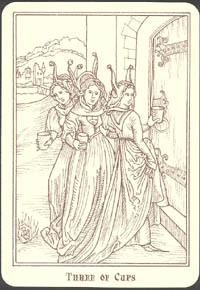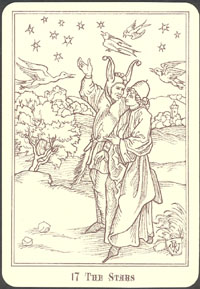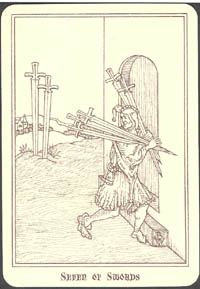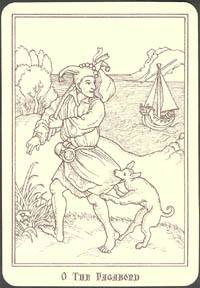|
 Italy has, not without reason, a living tradition for tarot: tarot was born in Italy. We have through
the years seen several serious Italian artists, who rightly can be termed "tarot artists", because
they have repeatedly and over a long period of time explored that special artistic challenge, that
the creation of a tarot deck can be. A few names which can be mentioned in this regard are Elisabetta
Cassari and Amerigo Folchi, who respectively have 3 and no less than 20 tarot decks behind them. Both
worked with tarot for years and both were introduced to tarot and inspired to make tarot decks by Vittore
Arienti, the late, well-known, Italian collector and publisher, who through his "Editione Solleone" made
a number of tarot and playing cards available to collectors, both contemporary packs and reprints of
classical decks.
Italy has, not without reason, a living tradition for tarot: tarot was born in Italy. We have through
the years seen several serious Italian artists, who rightly can be termed "tarot artists", because
they have repeatedly and over a long period of time explored that special artistic challenge, that
the creation of a tarot deck can be. A few names which can be mentioned in this regard are Elisabetta
Cassari and Amerigo Folchi, who respectively have 3 and no less than 20 tarot decks behind them. Both
worked with tarot for years and both were introduced to tarot and inspired to make tarot decks by Vittore
Arienti, the late, well-known, Italian collector and publisher, who through his "Editione Solleone" made
a number of tarot and playing cards available to collectors, both contemporary packs and reprints of
classical decks.

Even though the creator of "The Ship of Fools Tarot", Brian Williams, was not Italian but American,
he fit very well into this Italian concept of being called a tarot artist, having a close connection to
Italy as an art historian with a BA in Italian Renaissance Iconography Studies from The University of
California, and by having been the creator of no less then five tarot decks himself, the first designed
during his university days and not surprisingly, called "Renaissance Tarot" (1987). This deck
was later accompanied by a comprehensive book explaining in great detail the idea of medieval and
Italian Renaissance art in relation to the tarot tradition.

The current tarot deck and book by Brian Williams is based upon "Das Narrenshiff", a German classical
series of woodcut prints and their accompanying text made by Sebastian Brant, dating back to the
late 15th Century and illustrating the foolishness of humanity. Williams noticed that many tarot
elements were inherent in this famous series of prints; the majority of the traditional major arcana
cards - the trump suit - could be found directly among Brant's images. For the remaining cards Brian
Williams constructed the relevant tarot images by putting together details from different prints.
Williams' drawing style is simple with his use of thin lines and in his redrawings of the "Narrenshiff"
illustrations, he omitted such details that were not necessarily related to the tarot, thus making the
relevant details more visible. Instead of sticking to the Renaissance tradition, where the tarot's
number cards were rather decorated than illustrated, Williams decided to use Pamela Colman Smith's
illustrations of the number cards as a model, still finding their single elements in Brant.
 In Brian Williams' 207 page accompanying text "Book of Fools" he compares and illustrates each of
the 78 cards along with the corresponding Marseille- and Waite-Smith Tarot cards and with the relevant
"Narrenshiff" images. A translation of the short verses that accompany Brant's prints is also given.
In Brian Williams' 207 page accompanying text "Book of Fools" he compares and illustrates each of
the 78 cards along with the corresponding Marseille- and Waite-Smith Tarot cards and with the relevant
"Narrenshiff" images. A translation of the short verses that accompany Brant's prints is also given.
The Ship of Fools Tarot is another recommendable tarot deck/book set from Llewellyn Publishers, who
right now appear to be the major tarot publishers in the USA, at least with regards to quality. Yet there
is an unbecoming flaw in this book. Opposite the title page we can find the usual instructions on how
to write to the author through the publisher. That instruction should have been removed. Brian Williams
died in April 2002, only 44 years of age, which also the publisher notes a few pages later. The Ship
of Fools Tarot should become Brian Williams last contribution to the tarot. Along with his
"Renaissance Tarot", "Po-Mo Tarot", "Angel-Journey Tarot", "Minchiate Tarot" and his book for Michael
Goepferd's "Light and Shadow Tarot", his position as a genuine tarot artist and author is firmly
cemented.
|